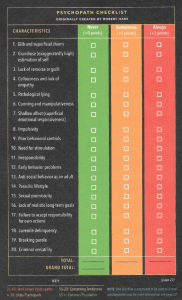The one sentence summary
Psychopaths are everywhere but you can beat them at their own game by understanding how they operate.
Can’t be bothered to read it? Too much screen time lately? Listen to the 5-minute podcast in two parts.
WHAT THE BOOK SAYS 
- Some people are exceptionally manipulative. They enjoy controlling others, often with their charm, and will do anything to get what they want.
- The original Psychopath Checklist* was created by Robert Hare, one of the most respected researchers of the subject. It requires the scrutiny of 20 behavioural characteristics, scoring them as happening never (0 points), sometimes (1) or always (2). These range from glib and superficial charm, grandiose (exaggeratedly high) estimation of self, lack of remorse or guilt, callousness and lack of empathy, through pathological lying, cunning and manipulativeness, poor behavioural controls and need for stimulation, to serious issues such as juvenile delinquency and criminality. *Checklist at the end of this post – click to enlarge.
- When these are added up, the common population scores under 15 points, 15-20 shows concerning tendencies, 20-30 is likely a psychopath, and 35-40 is a definite. Try scoring yourself and colleagues.
- Your weaknesses and behaviour traits can be exploited by others, so it pays to understand the different types. To understand yourself and others, consider the four types of human behaviour as defined by William Moulton Marston’s colour coding system. This is often called DISC* (dominance, inducement, submission, compliance).
- Red = dominant (don’t get in their way)
- Yellow = inspiring (head in the clouds)
- Green = stable (change is difficult and may never happen)
- Blue = analytical (only perfection will do)
*For more detail, see Surrounded By Idiots by the same author, on this blog.
- Common manipulation techniques include:
- Arbitrary positive enforcement: giving strong praise, and then sometimes withholding it.
- Love bombing: over the top initial adoration, followed by withdrawal.
- Negative reinforcement: the manipulator stops doing something you don’t like when you start doing something they do like.
- Unfathomable smokescreens: shifting the focus from the actual issue by claiming that you are the problem.
- Having your feelings turned against you: putting pressure on someone’s weak points, particularly ones that they are not proud of.
- The triangle drama: enthusiastically talking about or introducing a third party.
- Gaslighting: distorting someone’s sense of reality and making them question their own sanity (from the 1944 film Gaslight in which a husband drives his wife mad by secretly changing the lighting and many other environmental elements whilst denying it).
- The silent treatment: passive-aggressively refusing to comment at all.
WHAT’S GOOD ABOUT IT
- The main driving forces behind why people manipulate each other are:
- Theoretical: wanting to learn more.
- Practical-economic: to gain possessions and money.
- Aesthetic: to be stylish or acquire stylish trappings.
- Social: to look better in front of others.
- Individualistic: to gain personal power.
- Traditional: to gain standing in hierarchies (such as a religious group).
- The formula for dealing with a manipulator is:
- When you… (describe what they are doing that you want them to stop)
- I feel… (describe exactly what sort of negative feeling is created)
- If you stopped… (specify the objectionable behaviour) and instead… (describe the behaviour you want)
- Then I am going to feel… (the feeling you want to have – better outcome)
- Research shows that psychopaths are most common in these professions: CEO, lawyer, media jobs (TV/radio), sales, surgeon and journalist.
WHAT YOU HAVE TO WATCH
- More often than not, the advice to those being manipulated by a psychopath is to get out of there, which is not always possible.
*Those wanting to pursue this topic further might want to look at The Psychopath Test by Jon Ronson.

